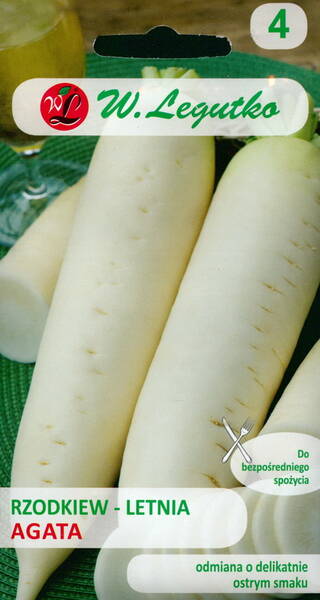Ex Tax: 1.35€
Early maturing variety. Ripens in 50-60 days after sowing. Root crops are long, large, white, of delicate taste, do not outgrow for a long time. Suitable for fresh consumption and for long-term storage.
There are 90-120 seeds in 1 gram.
* Fresh manure should not be applied under turnips, radishes and rutabagas, because this leads to hollow roots and overgrowth of tops. High yields are obtained with an uninterrupted supply of moisture to plants throughout the entire growth period. Rutabaga, turnip, radish are cold-resistant crops, they tolerate light frosts. The optimum temperature for growing rutabagas and turnips is 15 - 18 degrees, radishes 18 - 20 degrees. At higher temperatures, the taste of root vegetables coarsens. The plot must be sunny. Rutabaga is sown in early spring no later than May 10-15. Turnips and radishes for summer and autumn consumption are sown at the same time as rutabaga. For winter consumption, radish is sown on June 10-15, turnip - July 10-15. These crops are sown both on a flat surface and on ridges with a row spacing of 35-40 cm for radishes and turnips and 25-30 cm for turnips. It is impossible to thicken the radish, in a row the distance is 20-25 cm. The seeds are planted to a depth of 1.5-2 cm. They are sown with dry seeds.
Seedlings are also used for growing rutabagas. When caring for crops, it is necessary to periodically loosen the aisles.
To scare away and fight cruciferous flea beetles, plants are sprayed with various infusions (garlic, tobacco, etc.) or sprinkled with ash. It is important to start doing this in advance, to prevent the reproduction of pests. When the first two true leaves are formed, thinning is carried out, leaving between the turnip plants up to 6-8 cm, and the turnip and radish - 13-18 cm. After the breakthrough, it is good to feed 10-15 g per square meter with nitrogen fertilizers. meter (or slurry diluted 3-4 times). After 20-25 days, fertilizing with phosphorus-potassium fertilizers is carried out at 10 g per sq. meter (potash fertilizers can be replaced with ash 200 g / sq. meter).
Harvesting root crops is best done before the onset of frost. The leaves of the root crops selected from the ground are cut off and temporarily covered with earth with a layer of 8-10 cm. With the onset of stable cool weather, the roots are placed in a cool storage. The minimum return period is at least 3-4 years.
Inadmissible predecessors: cabbage, radish.
Eng.: Oriental Radish. Bot.: Raphanus sativus L. (partim).
CULINARY SECRETS WITH ORIENTAL RADISH (DAIKON).
Japanese radish roots are used both fresh (in a variety of salads), boiled (for example, in vegetable and meat soups), fried and even salted or pickled.
Daikon is often stewed with meat or poultry, as it does not go sour when cooked for a long time and absorbs the flavor and juice of all other ingredients. In Japanese cuisine, this vegetable is served as a seasoning for sashimi and sushi rolls, while grated and seasoned with soy sauce, daikon is often used as a seasoning for fried fish. Young leaves of hairless varieties can be added to salads.
Daikon and red cabbage salad.
Daikon - 300 g, carrots - 100 g, red cabbage - 200 g, sour cream and salt - to taste.
Wash daikon and carrots, peel and chop on a coarse grater. Cut red cabbage into thin strips, mix with chopped carrots and daikon, season with sour cream (or mayonnaise) and salt.
Daikon salad with beef.
Daikon - 300 g, lean boiled beef - 200 g, onion - 100 g, vegetable oil - 4 tablespoons, parsley - 2 tablespoons, salt - to taste.
Boiled meat and raw daikon cut into small strips. Cut the onion into thin half rings and fry in oil until golden brown. Place all products in a salad bowl, add salt to taste, garnish with parsley.
Chicken and daikon in red wine sauce.
Chicken thighs (pieces, without skin and bones) - 450 g, salt and pepper - to taste, butter - 2 tablespoons, daikon (2x2 pieces) - 220 g, onion (2x2 pieces) - 1 pc., chicken broth - 375 ml, red wine -125 ml, soy sauce - 1.5 tablespoons, sugar - 1.5 tablespoons.
Season the chicken meat with salt and pepper. In a large skillet, dissolve 1 tbsp. l. butter, brown chicken thighs on all sides over high heat, then remove. Then put the onion and daikon and fry them for 1-2 minutes with vigorous stirring. Pour in the chicken broth, close the lid and bring to a boil. Open the lid, reduce the heat to medium and cook, stirring occasionally, for another 10 minutes. Add red wine, soy sauce and sugar and leave on fire for another 10 minutes. Then put the chicken in and cook for another 5 minutes over low heat until the meat is tender and the liquid level has reduced. Remove the pan from the heat and stir in 1 tablespoon of butter, add salt and pepper to taste.












